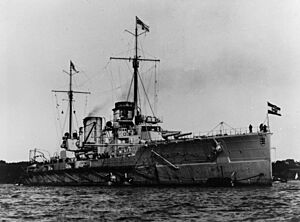Battle cruiser facts for kids
A battlecruiser was a type of large warship, a bit like a battleship. It was designed to be very fast, even faster than most battleships. To achieve this speed, battlecruisers usually had slightly thinner armor and sometimes lighter guns compared to battleships. They were also often longer and narrower.
Battlecruisers were built to outrun other large warships and to chase down smaller, faster enemy ships. They were mainly used in the 20th century. The Royal Navy in Britain was the first to invent the idea of the battlecruiser. Soon, many other countries around the world started building their own. Today, battlecruisers are no longer used, as more modern ships have taken their place.
Contents
What Was a Battlecruiser?
A battlecruiser was a powerful warship that combined the heavy guns of a battleship with the high speed of a cruiser. The idea was to create a ship that could hit hard and move fast. This made them very useful for scouting ahead of the main fleet or for quickly attacking enemy ships.
Design and Features
Battlecruisers were built for speed. This meant their engines were very powerful. To save weight and make them faster, their armor was often not as thick as a battleship's. This was a trade-off: more speed for less protection.
Their main weapons were large guns, similar to those on battleships. These guns could fire heavy shells over long distances. Battlecruisers also carried smaller guns for defense against torpedo boats and other threats.
History of Battlecruisers
The first battlecruisers were designed in the early 1900s. Admiral Jackie Fisher of the Royal Navy is often given credit for the idea. He believed that "speed is armor," meaning that a fast ship could avoid being hit.
Early Battlecruisers
The first battlecruiser was HMS Invincible, launched by Britain in 1907. Other countries, like Germany and Japan, quickly followed suit and built their own battlecruisers. These ships were seen as the future of naval warfare.
Battlecruisers in World War I
Battlecruisers played a big role in World War I. They were involved in several important naval battles. One of the most famous was the Battle of Jutland in 1916. In this battle, several British battlecruisers were sunk because their thinner armor could not withstand direct hits from German battleships. This showed that speed alone was not always enough to protect these powerful ships.
For example, HMS Queen Mary was one of the battlecruisers lost at Jutland. This event led to changes in how battlecruisers were designed and used.
After World War I
After World War I, some battlecruisers were rebuilt with thicker armor to make them more survivable. Others were converted into aircraft carriers. Countries continued to experiment with the battlecruiser concept, but their role started to change.
The End of Battlecruisers
By World War II, the role of the battlecruiser began to fade. New technologies, like aircraft carriers and faster, more heavily armored battleships, made them less necessary. Modern warships, such as guided-missile cruisers, can perform many of the tasks that battlecruisers once did, but with much more advanced weapons and protection.
Today, no battlecruisers are in active service. They remain an important part of naval history, showing how warship design evolved over time.
Images for kids
-
HMS Hood, the largest battlecruiser ever built, in Australia on 17 March 1924
-
Invincible, Britain's first battlecruiser
-
HMS Queen Mary, the last battlecruiser built before World War I
-
USS Alaska, one of the United States Navy's two "large cruisers"
See also
 In Spanish: Crucero de batalla para niños
In Spanish: Crucero de batalla para niños














